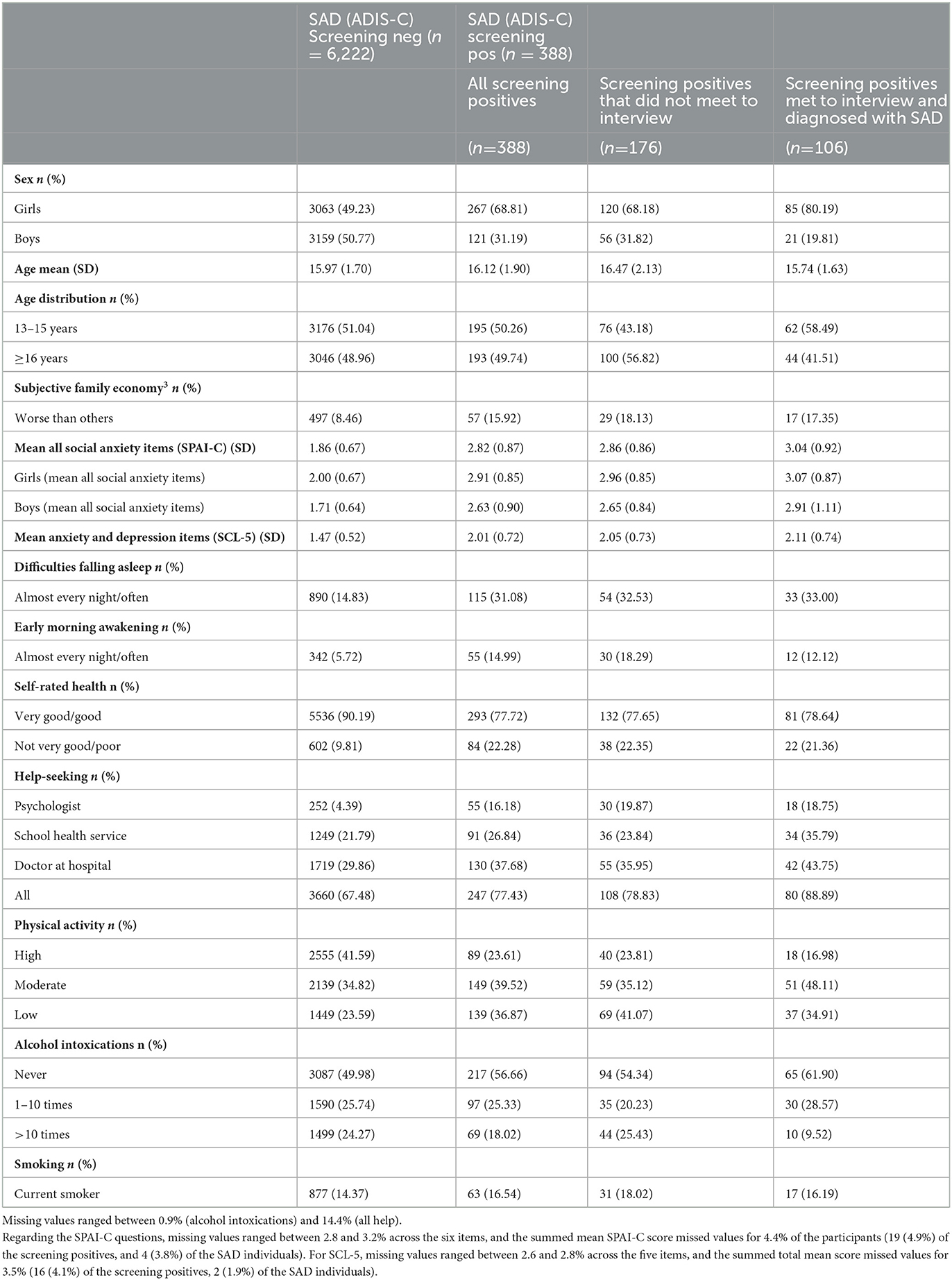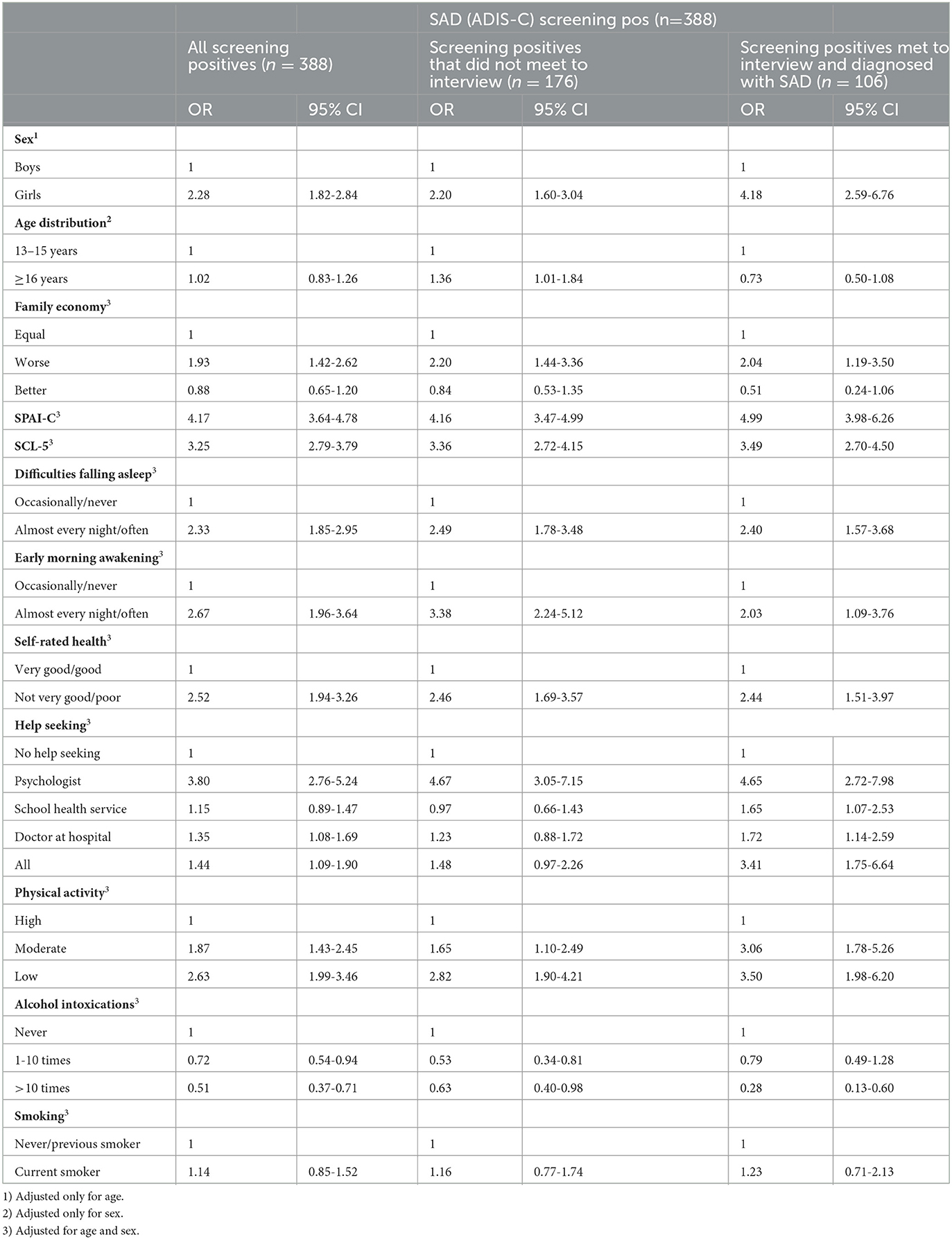- 1Faculty of Nursing and Health Science, Nord University, Levanger, Norway
- 2Department of Public Health and Nursing, Faculty of Medicine and Health Science, Norwegian University of Science and Technology, Trondheim, Norway
- 3Department of Mental Health, Norwegian University of Science and Technology, Trondheim, Norway
- 4Department of Public Health and Nursing, HUNT Research Centre, Norwegian University of Science and Technology, Trondheim, Norway
- 5Levanger Hospital, Nord-Trøndelag Hospital Trust, Levanger, Norway
- 6Department of Psychology, Faculty of Social and Educational Sciences, Norwegian University of Science and Technology, Trondheim, Norway
A corrigendum on
Sociodemographic correlates and mental health comorbidities in adolescents with social anxiety: the Young-HUNT3 study, Norway
by Jystad, I., Bjerkeset, O., Haugan, T., Sund, E. R., and Vaag, J. (2021). Front. Psychol. 12:663161. doi: 10.3389/fpsyg.2021.663161
In the published article, there was an error in Table 1 as published. In the rows, “Mean all social anxiety items (SPAI-C) (SD)” and “Mean anxiety and depression items (SCL-5) (SD)” the mean values for SPAI-C and SCL-5 were erroneously reported with standard errors (SE) instead of standard deviations (SD). The corrected Table 1 appears below.

Table 1. Descriptive characteristics of adolescents in Young-HUNT3 categorized/identified as Anxiety Disorders Interview Schedule for DSM IV: child version (ADIS-C) screening negative, ADIS-C screening positive, screening positive not met to interview, and as diagnosed social anxiety disorder (SAD) cases.
In addition, there was also an error in Table 2 as published. The row “All” in the section “Help Seeking” was erroneously excluded. The corrected Table 2 appears below.

Table 2. Age- and sex adjusted associations (odds ratio and 95% confidence interval) between sociodemographic and health-related variables and the different subgroups of social anxiety.
In addition, there was also an error in Materials and methods, Measures, “Social Anxiety Disorder Screening and Clinical Interview (n = 6,610 and 212)”, “Anxiety Disorders Interview Schedule for DSM IV: Child Version”, Paragraph 1. The number of participants who were asked the three social anxiety items was incorrectly stated as “n = 6,6610”, but should be “n = 6,610”. The corrected paragraph appears below.
The Anxiety Disorders Interview Schedule for DSM IV: Child Version is a semi-structured interview used to diagnose anxiety disorders and other mental disorders in children and adolescents, according to the DSM-IV criteria (American Psychiatric Association, 2000; Rasmussen and Neumer, 2015). In the present study, the interview modules for SAD, generalized anxiety disorder (GAD), separation anxiety disorder (SEP), specific phobias (SPH), obsessive-compulsive disorder (OCD), post-traumatic stress disorder (PTSD), dysthymia, and depression were used. For more convenient administration and coding, the modules were slightly shortened. In addition, questions regarding symptoms of substance abuse were asked, yet a diagnostic evaluation of substance abuse cannot be set based on the ADIS-C interview alone (Rasmussen and Neumer, 2015). The original version of ADIS-C has shown promising reliability (Lyneham et al., 2007), whereas research on psychometric properties of the Norwegian version is limited (Rasmussen and Neumer, 2015). However, the instrument is widely used in specialist health service, and items largely resemble the diagnostic criteria described in DSM-IV. It is highly recommended that it is used/applied only by trained clinicians with knowledge to the instrument and the diagnostic criteria (Rasmussen and Neumer, 2015). All participants (n = 6,610) were asked the following three social anxiety items from the ADIS-C (yes/no): “When you are with others, at school, in restaurants or at parties, do you ever feel that people might think that something you do is stupid or dumb?”, “When you are with other people at school, restaurants, or parties, do you think that people might laugh at you?”, and “When you are in these situations with others (school, restaurants, and parties), do you worry that you might do something that will make you feel ashamed or embarrassed?”. Individuals who answered yes to one or more questions were considered SP (n = 388) and invited to participate in a complete ADIS-C interview performed by specially trained psychiatric nurses. Those who answered no to all three questions were considered screening negative (SN; n = 6,222).
The authors apologize for these errors and state that this does not change the scientific conclusions of the article in any way. The original article has been updated.
Publisher's note
All claims expressed in this article are solely those of the authors and do not necessarily represent those of their affiliated organizations, or those of the publisher, the editors and the reviewers. Any product that may be evaluated in this article, or claim that may be made by its manufacturer, is not guaranteed or endorsed by the publisher.
Keywords: social anxiety disorder, adolescence, ADIS-C, self-report, sociodemographics, comorbidity, HUNT–study
Citation: Jystad I, Bjerkeset O, Haugan T, Sund ER and Vaag J (2023) Corrigendum: Sociodemographic correlates and mental health comorbidities in adolescents with social anxiety: the Young-HUNT3 study, Norway. Front. Psychol. 14:1163212. doi: 10.3389/fpsyg.2023.1163212
Received: 10 February 2023; Accepted: 25 April 2023;
Published: 18 May 2023.
Edited by:
José Manuel García-Fernández, University of Alicante, SpainReviewed by:
Barbara Benoliel, Walden University, United StatesCopyright © 2023 Jystad, Bjerkeset, Haugan, Sund and Vaag. This is an open-access article distributed under the terms of the Creative Commons Attribution License (CC BY). The use, distribution or reproduction in other forums is permitted, provided the original author(s) and the copyright owner(s) are credited and that the original publication in this journal is cited, in accordance with accepted academic practice. No use, distribution or reproduction is permitted which does not comply with these terms.
*Correspondence: Jonas Vaag, am9uYXMudmFhZ0Bub3JkLm5v
 Ingunn Jystad
Ingunn Jystad Ottar Bjerkeset
Ottar Bjerkeset Tommy Haugan
Tommy Haugan Erik R. Sund
Erik R. Sund Jonas Vaag
Jonas Vaag